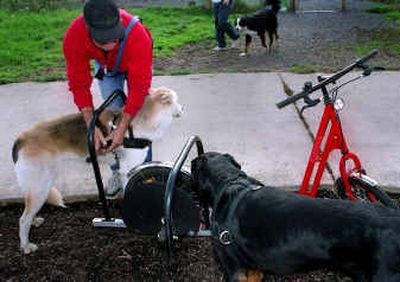Harnessing your pooch’s potential

EUGENE, Ore. – Mark Schuette didn’t even own a dog a year and a half ago but the need for a better way for people to exercise their dogs almost reached out and bit him as he moved around his hometown of Bend.
“I saw people on their bicycles with their dog on a leash pulling them – or on skateboards or roller blades. I saw women pushing babies in three-wheeled strollers and they’d also have a dog with them and the dog’s not doing anything, except trotting along and maybe getting tangled up every once in a while.
“Everybody is trying to get their dogs to help pull,” Schuette said. “I knew there was a better way.”
After some tinkering in his garage, Schuette had his “better way” ready to market.
He calls it the Dog Powered Scooter, an aptly descriptive name for an adult-sized version of a child’s sidewalk scooter – with an outrigger to which a dog can be harnessed.
The animal walks or trots alongside the Dog Powered Scooter.
It’s a snap to operate, as Schuette demonstrated during a recent trip to a “dog park” in south Eugene. First timers had no trouble using scooters powered by Schuette’s dog and one he borrowed from a friend.
“It’s a blast for you, the rider, and good exercise for your dog,” Schuette said.
The beauty of the Dog Powered Scooter, Schuette said, is that “the dog is always in the same position and can only go straight ahead. The control that offers is even better than a leash.”
A leash, for example, doesn’t come with steering handle and heavy duty mountain bike-style brakes. The Dog Powered Scooter does.
“With your weight on the scooter and the brakes applied, the dog cannot go anywhere,” said Schuette, who works as a designer when he’s not tinkering with metal. His other other creations include a dog carrier for a motorcycle and a rack that allows a bicycle to be carried on a motorcycle.
Turning the scooter’s steering handle puts pressure on one side of the dog harness, in effect gently tugging the dog in the direction it needs to go.
The Dog Powered Scooter has one huge advantage over, say, cross-country skiing with dogs, called skijoring, and other more traditional dog-powered forms of recreation: There’s no training involved with his scooter, Schuette said.
It’s simply a matter of getting the dog accustomed to being harnessed and walking along beneath the curved outrigger, made of bicycle tubing.
That usually can be accomplished in 10 to 15 minutes, Schuette said.
Then the dog can be attached to the outrigger using swiveled fasteners on either side of the dog. The fasteners are adjustable so they can be set to shoulder height on any dog.
In all other dog-powered forms of recreation, the dog is out in front of the rider and must be trained to respond to verbal directional commands.
“It takes months to teach a dog to learn how to, what is it, ‘Gee and Haw,’ ” Schuette said, referring to traditional sled dog commands for turns to the left and right, respectively.
And even when executed properly, the turns tend to be wide and lacking in precision.
Then, of course, there’s the problem that occurs when a cat or a squirrel scampers across the path and the dog forgets its training.
“Mine is the first system where you have total control over the steering,” Schuette said.
The scooter has been well-received by dog owners “who want something fun to do while spending time with their dogs,” he said. “One out of every hundred people says it’s abusing the dog; the other 99 say it’s the coolest thing they’ve ever seen.”
The scooter does not put undue strain on the dog, Schuette said. In fact, his original design included a wheel on the outrigger, but that was dropped when Schuette discovered there really is no downward pressure on the dog.
And pulling the scooter is not difficult.
“You give a kick or two to help get the scooter going, then it only takes 10 to 20 pounds of pressure for the dog to keep it rolling along,” he said. “It’s nothing for these dogs to keep it at speed because, on wheels, the scooter has a very low rolling resistance.”
Nonetheless, Schuette recommends the rider weigh no more than 100 pounds more than the dog pulling the scooter.
Heavier riders – or people with more than one pooch who needs exercising – might be interested in tandem or even “triple” versions of the scooter.
Schuette said tandem models can be configured either with an outrigger on each side, or with one behind the other on one side of the scooter.
Schuette said he considered connecting his outrigger to a bicycle, but decided the scooter was better.
“On a bicycle, it’s too easy to actually outrun a dog,” he said. “You’re just sitting there pedaling and you’re setting the pace. But on this the dog pretty much sets the pace.”
An ideal pace for exercising a dog is often too slow for a bicycle but too fast for human walking pace, he said.
“With this you can stand on it and still get a ride while the dog’s walking. With a bicycle, if you slow down to a dog’s walk, you get ‘tippy.’ So this is a much more appropriate vehicle to attach to a dog.”
Schuette buys scooters and harnesses from other manufacturers, then adds the outrigger and all the other necessary hardware in his workshop.
The completed unit sells for $450, plus about $50 shipping.